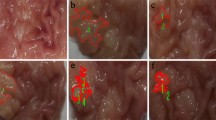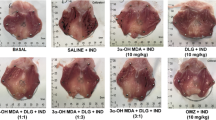Abstract
The plausible mechanism by which dexamethasone makes the gastric mucosa susceptible to ulceration has been studied. As acid aggravates ulcer, the role of dexamethasone on acid secretion was first investigated. Dexamethasone stimulates both basal and drug (mercaptomethylimidazole)-induced gastric acid secretion by 100 and 50% respectively in male Wister rats 24 h after intramuscular administration at the dose of 1 mg/kg body wt. This stimulated acid secretion is 93% blocked by cimetidine indicating increased liberation of histamine in the process. Pretreatment of dexamethasone before 24 h produces ulcer in 30% of the pylorus- ligated rats and aggravates the ulcer index by 82% in both pylorus and esophagus ligated rats. The incidence of ulceration in the latter cases is also increased by 25%. As mucosal prostaglandin synthetase and peroxidase play an important role in gastroprotection through biosynthesis of prostaglandin and by scavenging endogenous H2O2 respectively, the effect of dexamethasone on the activities of these gastroprotective enzymes were studied. Prostaglandin synthetase and peroxidase activities of the mucosa are significantly inhibited by 87 and 83% respectively by 24-h pretreatment with dexamethasone. The results indicate that dexamethasone makes the mucosa prone to ulceration by inhibiting the activity of prostaglandin synthetase to block the gastroprotective action of prostaglandin and also by inhibiting the peroxidase, thereby elevating the endogenous H2O2 level to generate more reactive hydroxyl radical responsible for the mucosal damage.
Similar content being viewed by others
References
Duval D, Durant S, Delarche H: Non-genomic effects of steroids: Interaction of steroid molecules with membrane structure and function. Biochim Biophys Acta 737: 409–442, 1983
Halter F, Mullener C, Kohler B, Saner U, Smith GM: Die wirkung von kortikosterpoiden auf die Magrnsauresekretion der Ratte. Schweiz Med Wscher 101: 755–756, 1971
Gray SJ, Benson AJ, Reifenstein RW, Spiro MH: Chronic stress and peptic ulcer: Effect of corticotrophin ( ACTH ) and cortisone on gastric secretion. J Am Med Assoc 147: 1529–1537, 1951
Haikonen M, Rasanen T: Hydrogen ion concentration in the gastric juice after pylorus ligation in dexamethasone treated rat. Acta Physiol Scand 65: 378–382, 1965
Rasanen T: Effect of dexamethasone, prednisolone and cortisol on the mast cells and tissue eosinophils in the rat gastric mucosa. Acta Endocr (Kbh) 41: 432–436, 1962
Plainos TC, Philippu AJ: Effect of prednisone (Meticorten) on gastric secretion and urine and uropepsin excretion in dogs. Gastroenterology 35: 183–189, 1958
Bandyopadhyay U, Bhattacharyya DK, Chatterjee R, Chakraborty T, Banerjee RK: Effect of dexamethasone on the peptic activity of gastric lumen and mucosa. Biochem Pharmacol 45: 879-883, 1993.
Tsukada S, Ichinose M, Tatematsu M, Tezuka N, Yonezawa S, Kakei N, Matsushima M, Miki K, Kurokawa K, Kageyama T, Takahashi K, Fukamachi H: Glucocorticoids inhibit the proliferation of mucosal cells and enhance the expression of a gene for pepsinogen and other markers of differentiation in the stomach mucosa of the adult rat. Biochem Biophys Res Commun 202: 1–9, 1994
Hall BD: Gastric ulcer associated with cortisone therapy. Gastroenterology 25: 80–83, 1953
Robert A, Nezamis JE: Ulcerogenic property of steroids. Proc Soc Exp Biol Med 99: 443–447, 1958
Gidener S, Koyuncuoglu M, Gelal A, Gumustekin M, Guven H, Bokesoy A, Gure A: Circadian rhythmicity in serotonin-induced acute gastric mucosal injury in rats. Int J Exptl Pathol 79: 105–108, 1998
Karpani de Kaski M, Rentsch R, Levi S, Hodgson HJ: Corticosteroids reduce regenerative repair of epithelium in experimental gastric ulcer. Gut 37: 613–616, 1995
Perretti M, Mugridge KA, Wallace TL, Parente L: Reduction of aspirin-induced gastric damage in rats by interleukin-1 beta: Possible involvement of endogenous corticosteroids. J Pharmacol Exp Ther 261: 1238–1247, 1992
Filaretova LP, Filaretova AA, Makara GB: Corticosterone increase inhibits stress-induced gastric erosions in rats. Am J Physiol 274: G1024–G1030, 1998
De SK, Banerjee RK: Glucocorticoid effects on gastric peroxidase activity. Biochem Biophys Acta 800: 233–241, 1984
Das D, De PK, Banerjee RK: Thiocyanate, a plausible physiological electron donor of gastric peroxidase. Biochem J 305: 59–64, 1995
Das D, Banerjee RK: Effect of stress on the antioxidant enzymes and gastric ulceration. Mol Cell Biochem 125: 115–125, 1993
Bandyopadhyay U, Bhattacharyya DK, Chatterjee R, Banerjee RK: Localization of gastric peroxidase and its inhibition by mercaptomethylimidazole, an inducer of gastric acid secretion. Biochem J 284: 305–312, 1992
Bandyopadhyay U, Bhattacharyya DK, Banerjee RK: Mechanism-based inactivation of gastric peroxidase by mercaptomethylimidazole. Biochem J 296: 79–84, 1993
Bandyopadhyay U, Chatterjee R, Chakraborty TK, Ganguly CK, Bhattacharyya DK, Banerjee RK: Activation of parietal cell by mercaptomethylimidazole – a novel inducer of gastric acid secretion. Biochem Pharmacol 54: 241–248, 1997
Bhattacharjee M, Chakraborty Y, Ganguly C, Banerjee RK: Inhibition of gastric mucosal prostaglandin synthetase activity by mercaptomethylimidazole, an inducer of gastric acid secretion – plausible involvement of endogenous H2O2. Biochem Pharmacol 56: 905–913, 1998
Choquet A, Magous R, Bali JP: Gastric mucosal endogenous prostanoids are involved in the cellular regulation of acid secretion from isolated parietal cell. J Pharmacol Expt Therap 266: 1306–1311, 1993
Miller TA: Protective effect of prostaglandins against gastric mucosal damage: Current knowledge and proposed mechanism. Am J Physiol 245: G601–G623, 1983
Das D, Bandyopadhyay D, Bhattacharjee M, Banerjee RK: Hydroxyl radical is the major causative factor in stress-induced gastric ulceration Free Rad Biol Med 23: 8–18, 1997
French JD, Longmire RL, Porter WR, Movius HJ: Extravagal influences on gastric hydrochloric acid secretion induced by stress stimuli. Surgery 34: 621–632, 1953
Cho HC, Ogle WC: Cholinergic-mediated gastric mast cell degranulation with subsequent H1 and H2 receptor activation in stress ulceration. Eur J Pharmacol 55: 23–33, 1979
Galvin GB: Selective norardenaline depletion markedly alters stress response in rat. Life Sci 37: 461–465, 1985
Senay CE, Levine RJ: Synergism between cold and restraint for rapid production of stress ulcers in rats. Proc Soc Expl Biol Med 124: 1221–1223, 1967
Brodie DA, Knapp PG: The mechanism of inhibition of gastric secretion produced by esophageal ligation in the pylorus-ligated rats. Gastroenterology 50: 787–795, 1966
Hakanson R, Hedenbro J, Liedberg G, Sundler F, Vallgren S: Mechanism of gastric acid secretion after pylorus and oesophagus ligation. J Physiol (London) 305: 139–149, 1980
Shay H, Komarov SA, Fels D, Meranze M, Gruenstein A, Siplet H: A simple method for the uniform production of gastric ulceration in the rat. Gastroenterology 5: 43–61, 1945
Lowry OH, Rosebrough NJ, Farr AL, Randall RJ: Protein mesurement with the folin phenol reagent. J Biol Chem 193: 265–275, 1951
Van Der Oudera FJ, Buytehek M, Nugteren DH, Van Drop DA: Purification and characterization of prostaglandin endoperoxidase from sheep vesicular glands. Biochim Biophys Acta 487: 315–331, 1977
McCallum RW, Prakash C, Campoli-Richards DM, Goa KL: Cisapride: A preliminary review of its pharmacodynamic and pharmacokinetic properties and therapeutic use as a prokinetic agent in gastrointestinal motility disorders. Drugs 36: 652–681, 1988
Black JW, Duncan WAM, Durant CJ, Parsons EM: Definition and antagonism of histamine H2 recepter. Nature 236: 385–390, 1972
Berglindh T, Helander HF, Obrink KJ: Effect of secretagogues on oxygen consumption, aminopyrine accumulation and morphology in isolated gastric glands. Acta Physiol Scand 97: 401–414, 1976
Iyer GYN, Islam DMF, Quastel JH, Biochemical aspects of phagocytosis. Nature (London) 192: 535–541, 1961
Turner E, Somers CE, Shapiro BM: The relationship between a novel NAD(P)H oxidase activity of ovoperoxidase and CN–-resistant respiratory burst that follows fertilization of sea urchin eggs. J Biol Chem 260: 13163–13171, 1985
Banerjee RK, Das PK, Bhattacharjee M: Gastric peroxidase and its role in cellular control of gastric acid secretion. Biol Oxid Sys 1: 505–513, 1990
Bhattacharjee M, Bose AK, Banerjee RK: Histamine H2-receptor mediated stimulation of gastric acid secretion by mercaptomethylimidazole. Biochem Pharmacol 38: 907–914, 1989
Baily JM, Makheja AN, Pash J, Verma M: Corticosteroids, cyclo–oxygenase mRNA level and prostanoid synthesis in cultured vascular cells. Biochem Biophys Res Commun 153: 1159–1163, 1988
Strue MG, Wolter D, Resch K: Glucocorticoids inhibit prostaglandin synthesis not only at the level of phospholipase A2 but also at the level of cyclooxigenase/PGE isomerase. Br J Pharmacol 98: 1287–1295, 1989
Robert A: The inhibitory effects of prostaglandins on gastric secretion: Their possible role in the treatment of gastric hypersecretion and peptic ulcer. In: G.B.J. Glass (ed). Progress in Gastroenterology, Vol III. New York, 1977, pp 777–801
Raptis S, vonBerger L, Dollinger HC, Fazekas AA, Pfeiffer EF: Hypergastrinemia induced by glucocorticoid and corticotrophin treatment in man. Am J Dig Dis 21: 376–380, 1976
Nagamachi Y, Taniguchi A, Ogata N, Nakamura T: Characterization of adrenocortical function, gastrin release and gastric secretion in duodenal ulcer etiology. Jpn J Surg 9: 196–202, 1979
Black HE: The effects of steroids upon the gastrointestinal tract. Toxicol Pathol 16: 213–222, 1988
Domschke S, Domschke W: Gastroduodenal damage due to drugs, alcohol and smoking. Clin Gastroenterol 13: 405–436, 1984
Piper JM, Daugherty JR, Griffin MR: Corticosteroid use and peptic ulcer disease: Role of nonsteroidal antiinflammatory drugs. Ann Intern Med 114: 735–740, 1991
Author information
Authors and Affiliations
Rights and permissions
About this article
Cite this article
Bandyopadhyay, U., Biswas, K., Bandyopadhyay, D. et al. Dexamethasone makes the gastric mucosa susceptible to ulceration by inhibiting prostaglandin synthetase and peroxidase - two important gastroprotective enzymes. Mol Cell Biochem 202, 31–36 (1999). https://doi.org/10.1023/A:1007018212822
Issue Date:
DOI: https://doi.org/10.1023/A:1007018212822




